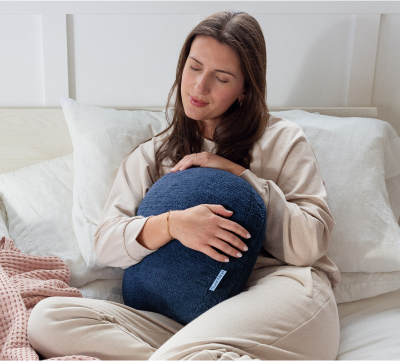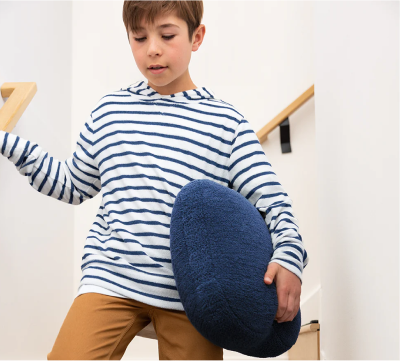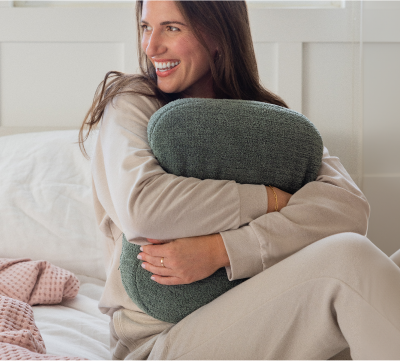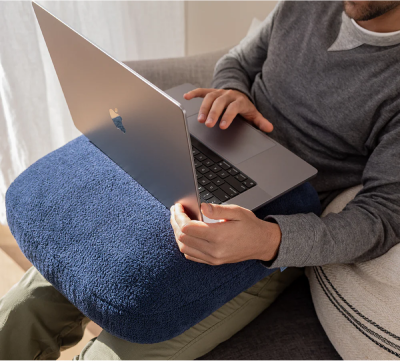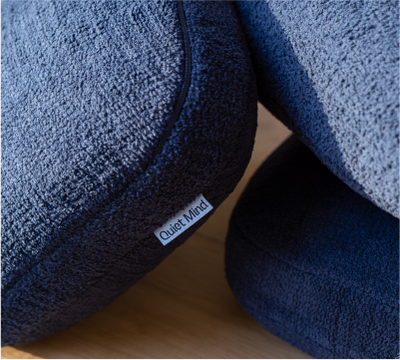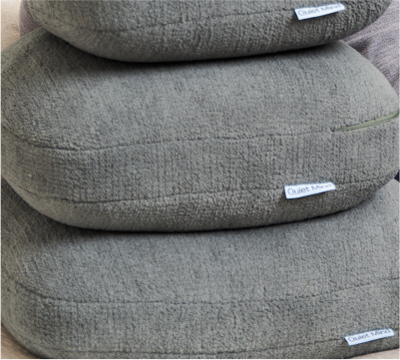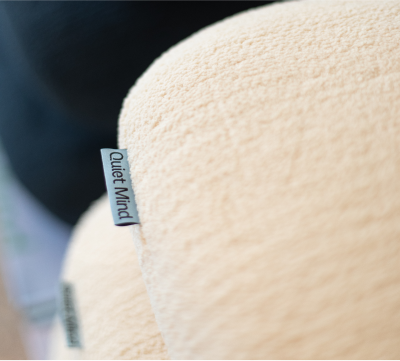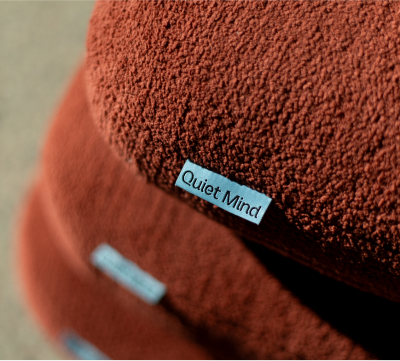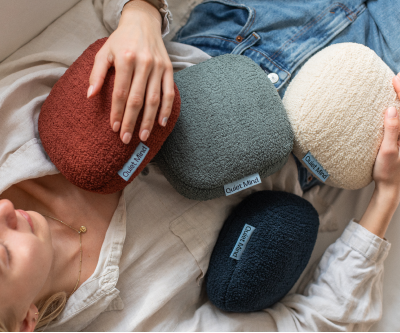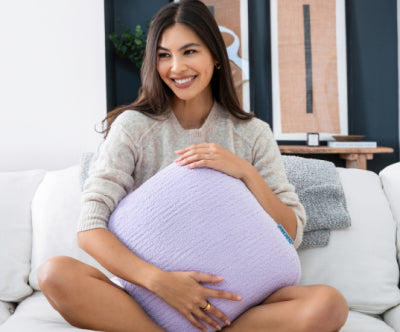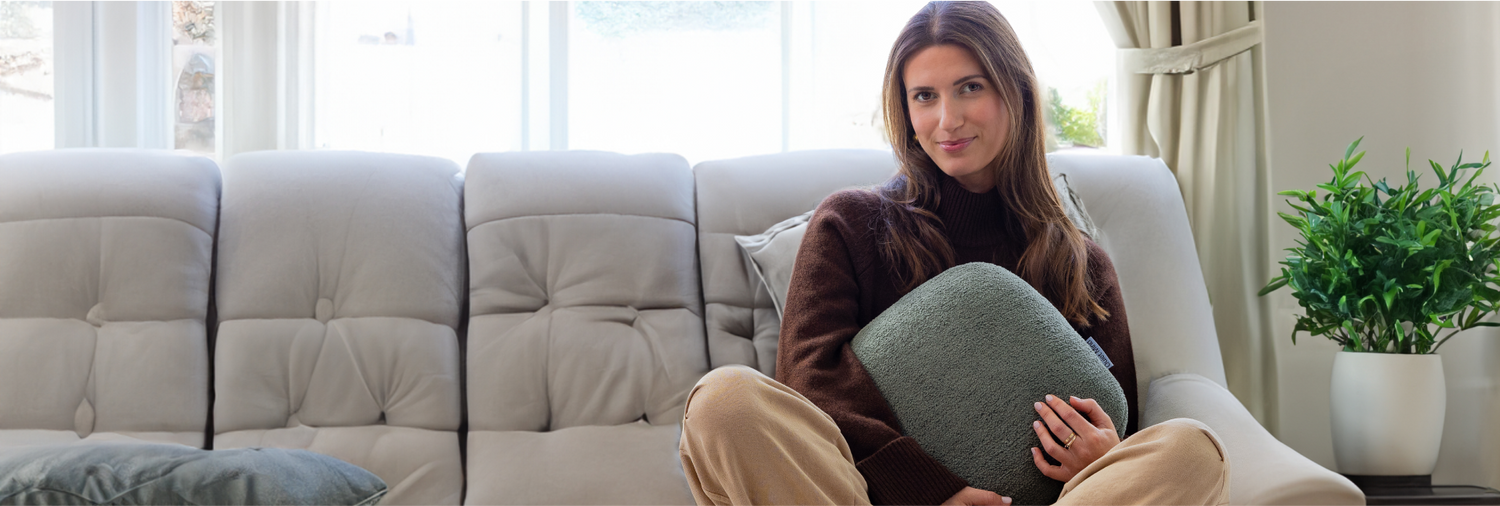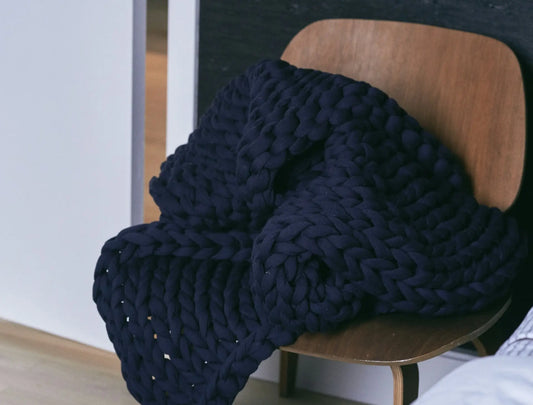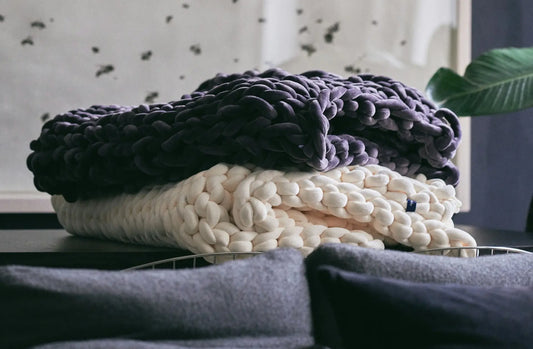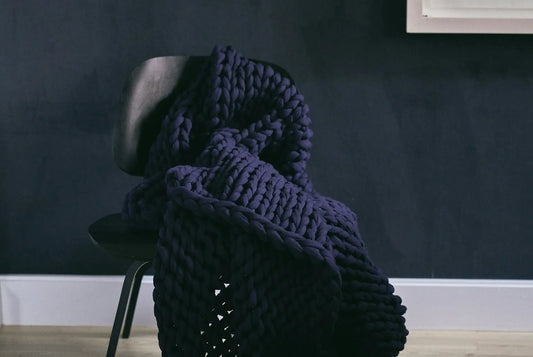The search for a good night’s sleep often begins with something simple: a change in bedding. For some, that means a heavy blanket with a calming effect, helping the mind and body settle. For others, it’s finding the ideal weighted blanket that finally feels like the missing piece in their sleep routine.
Weighted blankets offer more than warmth, they provide deep, calming pressure that can support sleep, reduce anxiety, and bring a sense of ease to overstimulated minds. But not all weighted blankets are created equal.
In this guide, we’ll walk through how to choose a weighted blanket that aligns with your needs, sleep style, and comfort preferences, so your nights feel softer, slower, and more grounded.
Why Choosing the Right Weighted Blanket Matters
A heavy weighted blanket can feel soothing for some and stifling for others. The right match can create a lasting calming effect that helps you fall asleep faster and stay asleep longer. The wrong choice may cause overheating, joint strain, or restlessness.
The Benefits of Weighted Blankets
When matched to your needs, the effectiveness of weighted blankets can be significant. An ideal blanket may:
-
Promote deeper, more restorative sleep.
-
Ease anxious thoughts and racing minds.
-
Support emotional balance through consistent deep touch pressure.
-
Reduce night-time movement for more continuous rest.
|
Benefit |
How It Helps |
|
Sleep Quality |
Encourages stillness, reduces wake-ups |
|
Anxiety Reduction |
Supports serotonin release and calm |
|
Emotional Regulation |
Helps regulate stress response naturally |
Weighted pillows share these benefits but make them more accessible. You don’t need to commit to full-body coverage, just placing a pillow across your torso before sleep can calm the nervous system in the same way.
The Risks of the Wrong Fit
A blanket doesn’t help if it adds weight in the wrong way or traps heat. Choosing a blanket that’s too heavy, too warm, or made from materials that limit airflow can lead to:
-
Overheating and discomfort
-
Difficulty moving during the night
-
Sensory overload or restlessness
-
Pressure on joints for side or stomach sleepers
The first step is deciding how you want to feel, and then finding the ideal weighted blanket weight and style to match that.
What Weight Should a Weighted Blanket Be?
When people buy their first weighted blanket, the most common question is: How heavy should a weighted blanket be?
The standard guidance is to use a weighted blanket that is about 10% of your bodyweight. This recommended weight range allows for grounding pressure without excessive restriction.
Weighted Blanket Weight Chart
This chart provides general guidelines for selecting a weighted blanket based on body weight. Use it as a starting point and adjust for personal comfort and health considerations.
|
Body Weight Range (lbs) |
Ideal Weighted Blanket Weight (lbs) |
Notes |
|
100–120 |
10–12 |
Lighter end for side sleepers or hot sleepers |
|
121–150 |
12–15 |
Balanced for most adults |
|
151–180 |
15–18 |
Better for back sleepers or those who want more stillness |
|
181–210+ |
18–21+ |
Use caution if prone to joint discomfort |
Note: Weights are approximate and based on common guidelines of around 10% of body weight. Always consider individual comfort, health conditions, and manufacturer recommendations.
Weighted pillows don’t follow this strict ratio. Instead, they are chosen by comfort, often weighing just a few pounds, so you can use them daily without concern for body-weight formulas.
Explore how Quiet Mind Weighted Pillows provide calming pressure in a lightweight, flexible design.
Adjust for Sleep Style, Age, and Sensory Needs
Adjust your weighted blanket choice as follows for sleep style, age, and sensory needs:
-
Side sleepers: Often prefer a slightly lighter blanket to avoid shoulder and hip compression.
-
Back or stomach sleepers: Can often handle more even pressure across the body.
-
Older adults or children: May need lighter options for comfort and safety.
-
Sensory sensitivities: Start light and increase slowly if tolerated.
If unsure, start with the lighter ideal blanket weight in your range. You can always add weight later by layering or upgrading.
What Size Weighted Blanket Do You Need?
Weighted blankets come in sizes that are often smaller than standard duvets or comforters. This ensures the weight stays on your body instead of hanging over the bed and pulling down.
Matching Blanket Size to Your Bed
-
Twin/full beds: A personal size blanket (around 39–54" wide) keeps weight where it’s needed.
-
Queen size beds: A queen size weighted blanket works well for solo sleepers who want full coverage.
-
King beds: Often better to use two personal blankets so each person can have their ideal weighted blanket weight without compromise.
|
Bed Size |
Typical Blanket Dimensions |
Notes |
|
Twin |
~39" x 75" |
Great as a throw blanket for couches too |
|
Full |
~54" x 75" |
Best for solo sleepers who want more drape |
|
Queen |
~60" x 80" |
Full coverage for one or shared between two |
|
King |
~76" x 80" |
Consider separate blankets for different weights |
Note: Dimensions are approximate and can vary by manufacturer. Always check product details for exact sizing before purchase.
Avoid oversized blankets that may drag or bunch, they can feel awkward and reduce the effectiveness of weighted blankets.
For Solo or Shared Sleep
Whether you sleep alone or with a partner affects your ideal weighted blanket size and weight.
-
Solo sleepers: A personal-sized blanket or one sized to your mattress (e.g., a twin, full, or queen size weighted blanket) keeps weight focused on your body without hanging over the edges. This also works well if you want to use it as a throw blanket on a sofa or chair.
-
Shared beds: Partners often have different comfort levels and personal preferences for the calming effect and temperature. In this case, two individual blankets, each with its own ideal weighted blanket weight, are often more comfortable than sharing one oversized option.
-
Different weight needs: If one partner prefers a lighter blanket and the other likes a heavy weighted blanket, having separate blankets means no one has to compromise on comfort or airflow.
Tip: Oversized weighted blankets may look appealing but can slide off during the night or create uneven pressure. The effectiveness of weighted blankets depends on consistent contact, so keep size close to your actual sleep space.
What’s the Best Material for a Weighted Blanket?
The ideal weighted blanket is as much about feel and airflow as it is about weight. Even if you’ve chosen the ideal weighted blanket weight, the wrong material can make you overheat, itch, or lose the calming effect that drew you to use a weighted blanket in the first place.
Breathable, Soothing Outer Materials
The outer fabric of a weighted blanket affects comfort, temperature control, and overall sleep experience. Here are some common breathable and soothing options to consider:
-
Cotton weighted blankets: Lightweight, soft, and breathable, making them one of the best weighted blankets for hot sleepers and year-round use.
-
Bamboo viscose: Naturally cool, silky to the touch, and hypoallergenic, ideal for sensitive skin or those needing high airflow.
-
Fleece or minky fabric: Plush and warming, perfect for cold sleepers or winter months, but can trap heat if you run warm.
-
Knitted weighted blankets: Use thick, open-weave yarns to combine weight with airflow, often doubling as a stylish throw blanket in living spaces.
|
Fabric |
Breathability |
Texture |
Best For |
|
Cotton |
High |
Smooth |
All seasons, hot sleepers |
|
Bamboo |
High |
Silky-soft |
Sensitive skin, cooling effect |
|
Fleece/Minky |
Low |
Plush |
Winter warmth |
|
Knitted |
Moderate–High |
Chunky, textured |
Style + airflow |
Fill Type: Glass, Plastic, Microbeads, or Steel
The inside material of weighted blankets plays a key role in creating the deep touch sensation. It also affects how evenly the weight is distributed, how much noise the blanket makes when you move, and the overall comfort during use.
-
Weighted blankets with glass beads: Small, smooth, and quiet; provide an even weight without bulk.
-
Weighted blankets with plastic poly pellets: Durable and budget-friendly but slightly bulkier; may shift more during the night.
-
Microbeads: Ultra-tiny, almost sand-like; create a very smooth drape but can migrate if stitching isn’t tight.
-
Steel shot beads: Dense and heavy, allow a heavy weighted blanket to use less fill volume, but can feel firmer.
|
Fill Type |
Weight per Volume |
Noise Level |
Notable Features |
|
Glass beads |
Heavy |
Silent |
Smooth, refined weight distribution |
|
Plastic poly pellets |
Moderate |
Slight rustle |
Durable, affordable |
|
Microbeads |
Light |
Silent |
Very smooth drape |
|
Steel shot beads |
Very heavy |
Minimal |
Less fill needed, denser feel |
Weighted pillows often use fine glass beads or microbeads because they provide consistent, quiet, evenly distributed pressure in a compact design. This makes pillows smoother and more predictable in comfort compared to blankets that can shift or pool.
Stitching and Construction
-
Box stitching: Keeps fill evenly distributed, preventing clumps.
-
Channel stitching: Allows some movement of beads for a more conforming feel.
-
Dual-layer designs: Add warmth in winter, but watch airflow if you’re heat-sensitive.
Matching a Weighted Blanket to Your Sleep Style
How you sleep and where your body experiences pressure, affects your ideal blanket choice.
For Side Sleepers
Here’s how to choose and adjust a weighted blanket for side sleepers:
-
Pick from the lower end of your body weight range to reduce shoulder and hip compression.
-
Use a knee pillow to maintain spinal alignment.
-
Softer fabrics like cotton or bamboo help prevent friction on shoulders.
For Back or Stomach Sleepers
If you sleep on your back or stomach, keep these tips in mind when selecting a weighted blanket:
-
Back sleepers: Can handle a heavier weight from the weighted blanket weight chart, as pressure is more evenly spread.
-
Stomach sleepers: Go lighter, too much weight can cause neck strain and restrict chest expansion.
For Restless Sleepers
If you tend to move a lot at night, here’s how to pick a weighted blanket that supports your sleep style:
-
Choose a heavy blanket only if you want less tossing and turning; lighter options maintain mobility.
-
Breathable covers prevent overheating during movement.
Weighted Blankets for Hot or Cold Sleepers
Temperature control is just as important as choosing your ideal weighted blanket weight. Even the best weighted blankets can feel uncomfortable if they trap too much heat or don’t keep you warm enough for a good night’s sleep.
For Hot Sleepers
If you tend to overheat, look for cotton weighted blankets, bamboo covers, or knitted weighted blankets that allow airflow. These materials wick moisture, maintain breathability, and keep the calming effect of deep touch pressure without adding unnecessary insulation.
-
Opt for lighter weights within your recommended weight range to reduce heat buildup.
-
Choose designs that allow air to circulate, open weaves or thinner duvets can help.
-
Avoid dense, plush fabrics like fleece or minky in warmer months.
For Cold Sleepers
If you run cool, the right heavy blanket can be both warming and soothing.
-
Consider fleece, minky, or flannel covers to add insulation.
-
Slightly heavier weights can enhance the cocoon-like feel while helping you relieve stress and stay warm.
-
A queen size weighted blanket with a thick cotton cover can double as a duvet alternative in winter.
|
Sleep Temperature |
Best Choice |
Avoid |
|
Hot |
Cotton or bamboo covers, knitted weighted blankets |
Heavy fleece or multi-layered duvets in warm months |
|
Cold |
Plush minky, fleece, thick cotton blends |
Ultra-light, open-knit blankets in winter |
Weighted pillows are temperature-neutral. They don’t cover your whole body, so they rarely cause overheating or leave you chilled, making them usable across seasons.
Special Considerations for Anxiety, ADHD, and Sensory Needs
While the benefits of weighted blankets often focus on comfort and better sleep, many people also turn to them for emotional support, focus, and sensory regulation. When chosen carefully, the effectiveness of weighted blankets can extend into managing anxiety, promoting a calming effect before bed, and even easing overstimulation for certain neurodivergent needs.
Anxiety and Stress Relief
Weighted blankets use deep touch pressure (DTP), which is a firm and even distribution of weight that can calm the nervous system. This type of pressure can lower the “fight or flight” response and promote the release of serotonin and melatonin.
These changes can slow heart rate and encourage relaxation before sleep. For people managing chronic anxiety or daily stress, a slightly heavier weighted blanket within a safe weight range can enhance this calming effect.
Use it as part of a consistent bedtime routine that also includes dim lighting, no screens, and slow breathing exercises. Over time, this combination can become a reliable tool for stress management and better quality sleep.
ADHD and Sensory Sensitivities
For individuals with ADHD, sensory processing disorder, or heightened sensory sensitivities, a weighted blanket can provide grounding input that helps reduce overstimulation and prepare the mind for rest.
Start at the lower end of your recommended weight range, often around 5 to 7 percent of body weight, to prevent overwhelm.
Choose breathable, soft materials such as cotton weighted blankets or bamboo covers to reduce tactile irritation and prevent overheating.
If the initial weight feels comfortable, you can increase it gradually. Adding familiar comfort items like a favorite pillow or throw can also create a predictable and soothing sleep environment.
Sleep Apnea and Breathing Concerns
Weighted blankets are safe for most healthy adults. If you have sleep apnea, COPD, asthma, or other breathing issues, speak with a healthcare provider before using one.
The concern is that excess weight on the chest can restrict airflow or make breathing more difficult during sleep.
If your provider approves the use of a weighted blanket, choose a lighter version that is under the typical 10 percent body weight guideline. Spread the weight evenly without bunching it around the chest. Knitted or loosely woven styles can help maintain airflow.
Combine the blanket with proper sleep positioning and any prescribed treatments, such as CPAP therapy, to reduce breathing strain while still gaining the calming benefits.
Chronic Pain or Joint Issues
For people with arthritis, fibromyalgia, or other chronic pain conditions, weighted blankets for arthritis can offer gentle pressure that promotes relaxation and eases stress. The key is to avoid excess weight on sensitive joints.
Select a lighter blanket or a knitted style that distributes weight more loosely. Position it to avoid direct pressure on painful joints. For example, drape it from the waist down or across the lap instead of covering the whole body. Using the blanket after gentle stretching or a warm bath can help increase comfort and improve sleep quality.
Safety Note: Weighted blankets are generally safe for adults with no significant health concerns, but they are not recommended for infants. For children or older adults with limited mobility, choose lighter weights and supervise use. If discomfort, overheating, or restricted movement occurs, remove the weighted blanket immediately.
Quiet Mind's Expert Tips Before You Buy a Weighted Blanket
Choosing the ideal weighted blanket is as much about testing as it is about reading a weighted blanket weight chart. Comfort is personal, and what feels perfect to one person may not work for another.
Test It, If You Can
If possible, try a blanket in-store or order from a brand that supports at-home testing. The effectiveness of weighted blankets is deeply personal, what feels like the best weighted blanket to one person might feel overwhelming to another.
Look for brands that offer:
-
Trial periods (often 14–30 days) so you can feel how the blanket performs through different points in your sleep cycle.
-
Flexible returns or exchanges so you can change the weighted blanket weight or size if your first choice isn’t right.
-
Removable, washable covers for easy care, especially if you’re buying a cotton weighted blanket or knitted weighted blanket you’ll use daily.
Tip: If you test in person, notice how quickly you feel relaxed. A good fit should bring a sense of grounding within minutes, without feeling trapped.
Look for Quality and Certifications
A blanket’s weight is important, but quality determines how long you’ll enjoy it. A well-made blanket not only lasts longer but maintains its ideal weighted blanket weight evenly over time.
Prioritize:
-
OEKO-TEX® Standard 100 or CertiPUR-US® certifications for non-toxic, skin-safe fabrics.
-
Consistent fill distribution through box-stitched or channel-stitched pockets, so glass beads, plastic poly pellets, or microbeads don’t pool in one area.
-
High-quality materials: weighted blankets with glass beads are smooth and quiet, weighted blankets with plastic pellets are durable and affordable, and steel shot beads add dense weight with less fill volume.
Why this matters: A low-quality blanket can lose its calming effect quickly if the fill shifts or stitching breaks, especially in heavy weighted blankets where more strain is placed on seams.
Match It to Your Life
The best weighted blankets are the ones that suit your everyday reality:
-
If you run hot, pick breathable fabrics and avoid thick duvets or plush covers.
-
If you share a bed, consider separate blankets so each person can get their ideal blanket weight without compromise.
-
If you want multi-season use, look for a blanket with interchangeable covers, one warm, one cooling.
Common Mistakes to Avoid When Buying a Weighted Blanket
Even the best weighted blankets won’t help if they’re mismatched to your needs. Here’s what to avoid:
1. Choosing Too Much Weight
A heavy weighted blanket can feel grounding, until it crosses into feeling restrictive. If the blanket should be about 10% of your body weight but you choose far more, you risk overheating, sore joints, or feeling trapped.
Better approach: Start with the lower end of your recommended weight from the weighted blanket weight chart. You can always add weight later by upgrading to a heavier model or layering a light throw blanket on top.
2. Picking the Wrong Size
An oversized blanket may look cozy, but extra fabric can pull the weight off your body, bunch at the edges, or cause uneven distribution. This reduces the effectiveness of weighted blankets, the calming effect relies on even, consistent contact.
Better approach: Match blanket size to your bed and your usage. For solo sleepers, a queen size weighted blanket often works perfectly; for shared beds, consider two personal-sized blankets so each person gets their ideal weighted blanket weight.
3. Ignoring Breathability
A blanket with poor airflow can cause night sweats, especially in summer. This is a common complaint with low-quality heavy blankets made from synthetic fabrics without ventilation.
Better approach: Choose breathable materials like cotton, bamboo, or knitted weighted blankets. If you love plush textures, use them only in cooler months or as an interchangeable cover.
4. Not Factoring in Sleep Position
What works for a back sleeper may not work for a side or stomach sleeper. Pressure distribution changes depending on how you lie, and the wrong choice can lead to discomfort or stiffness.
Better approach:
-
Side sleepers: go lighter to reduce pressure on shoulders and hips.
-
Back sleepers: can handle moderate to heavier weights evenly.
-
Stomach sleepers: stick to lighter blankets to keep airflow open and prevent chest or neck strain.
How to Know If a Weighted Blanket Is Working for You
The true test of a weighted blanket isn’t how it looks, it’s how it changes your nights. Consistent use of weighted blankets has been shown to enhance sleep quality while reducing anxiety, fatigue, and daytime sleepiness in adults with insomnia, according to a randomized clinical trial.
Positive Signs
If your weighted blanket is helping, you might notice:
-
You fall asleep faster, without tossing and turning as much.
-
You wake fewer times during the night and feel calmer when lying down.
-
Movement during sleep is reduced, and you notice a more settled sleep cycle.
-
You experience less anxiety or overstimulation at bedtime, enjoying the calming effect almost automatically when you use a weighted blanket.
Weighted pillows can show similar signs. You may notice the same calm when resting one across your chest or lap, especially if a full blanket feels too heavy or warm.
Signs It’s Not the Right Fit
If your weighted blanket isn’t working for you, you may find:
-
You feel overheated or notice trapped warmth, even with breathable fabrics.
-
You wake with stiffness, discomfort, or pressure points, a sign the weighted blanket should weigh less for your body type.
-
You feel confined or anxious under the weight, which interrupts rather than supports your good night’s sleep.
In these cases, a weighted pillow may be an easier alternative. It provides grounding pressure without covering the entire body.
Adjusting for Comfort
If it’s not working, don’t give up right away, sometimes subtle changes make all the difference:
-
Drop to a lighter ideal blanket weight.
-
Switch from plastic poly pellets to weighted blankets with glass beads or microbeads for a smoother, more even drape.
-
Use a cover that promotes airflow, like cotton or bamboo.
-
If discomfort persists, remove the weighted blanket entirely and reintroduce it in shorter sessions during wind-down time.
For many, swapping or combining with a weighted pillow can be the simplest adjustment; lighter, targeted pressure without the risk of overheating or restriction.
Comparing Weighted Blankets and Weighted Pillows: Why Versatility Wins
Both weighted blankets and weighted pillows use deep pressure stimulation (DPS); gentle, even pressure that calms the nervous system and helps the body relax. The difference lies in how they deliver that comfort.
Weighted blankets create full-body stillness, while weighted pillows offer targeted, flexible support that adapts to your lifestyle and sleep position.
Weighted Blankets: Full-Body Calm with Some Limitations
Weighted blankets are great for people who like feeling cocooned and still during rest. They promote deep sleep, reduce anxiety, and bring a sense of grounding, especially for back sleepers.
However, they can be less practical for daily or multi-position use. Common drawbacks include:
-
Overheating, as full-body coverage traps heat.
-
Limited mobility, making it harder to move freely.
-
Joint or chest pressure, especially for side or stomach sleepers.
-
Bulky use, difficult to manage or travel with.
A weighted blanket is best for those who prefer steady, motionless relaxation through the night.
Weighted Pillows: Adaptable Comfort for Any Setting
Weighted pillows bring the same science into a smaller, cooler, and more versatile form. They rest across your chest, lap, or shoulders, giving calming pressure exactly where you need it.
Here’s why weighted pillows often work better:
-
Stay cool: No full-body coverage or heat buildup.
-
Move freely: Easy to shift, reposition, or carry anywhere.
-
Targeted support: Focus on tense areas like shoulders or torso.
-
Use anytime: Perfect for reading, meditation, or quick calm breaks.
-
Gentle and safe: Great for children, older adults, or anyone sensitive to heavy blankets.
Weighted pillows deliver the same calming benefits, without the bulk or heat of a blanket.
The Better Choice for Everyday Calm
Weighted blankets provide stillness. Weighted pillows provide control, you decide when and how to use them. Their versatility makes them ideal for sleep, rest, or daily grounding rituals.
Quiet Mind’s Weighted Pillow embodies this flexibility. It offers soft, balanced pressure for the chest, lap, or shoulders. This helps your body relax naturally, whether at night or during the day. It’s the lighter, smarter way to find calm whenever you need it.
About Quiet Mind
At Quiet Mind, we believe the best weighted blankets are those that work in harmony with your body, supporting your sleep without adding strain or discomfort.
Our guides help you choose with confidence, so your blanket delivers the calming effect and good night’s sleep you’re looking for.
One of our most versatile tools for comfort is the Quiet Mind Weighted Pillow. It offers the same deep touch pressure you’d get from a blanket but in a smaller, more flexible form.
Perfect for your chest, lap, or shoulders, it’s ideal for hot sleepers, side sleepers, or anyone who wants targeted comfort without a full heavy blanket. It’s an easy way to make deep, restorative rest part of your nightly routine, no matter the season.
Frequently Asked Questions
What is a weighted blanket, and how does it work?
A weighted blanket uses evenly distributed weight to provide deep pressure stimulation, calming the nervous system, reducing stress, and promoting relaxation for better sleep and emotional comfort.
How do I choose the right weight for my blanket?
Select a blanket about 10% of your body weight. Adjust based on comfort, mobility, and sensitivity to ensure it soothes without restricting movement or feeling overwhelming.
What size weighted blanket should I get?
Choose a size matching your bed and sleep space. It should cover your body comfortably without excessive overhang, staying centered and distributing weight evenly through the night..
What materials are best for a weighted blanket?
Breathable cotton and bamboo promote airflow and cooling. Fleece offers warmth. Glass beads provide quiet, balanced weight, while fabric choice influences comfort for sensitive or easily irritated skin.
Will a weighted blanket help with anxiety or insomnia?
Many benefit from reduced anxiety and better sleep, as deep pressure reduces cortisol, boosts serotonin and melatonin, and creates a grounded, calming sensation that supports relaxation and rest.
